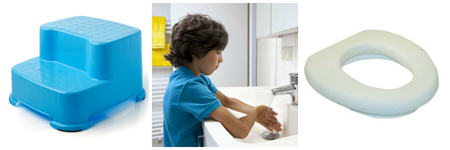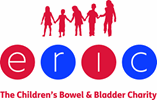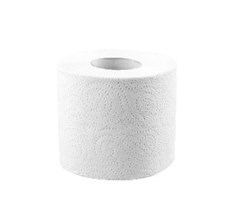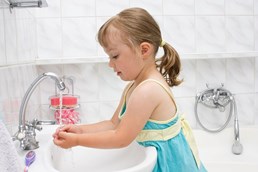Going to the toilet has a lot of steps. Your child needs to know that they need to go. They need to be able to let you know. They then need to get to the potty or toilet in time. Next they have to take down their pants and trousers. Then sit on the potty or toilet safely. Next they need to have a wee and/or a poo. They need to learn to wipe or wash themselves. Then pull their clothes up and flush the toilet. Finally they need to wash and dry their hands.
 Toilet training is challenging for everyone. Some children get it in a matter of days, but for others it can take longer.
Toilet training is challenging for everyone. Some children get it in a matter of days, but for others it can take longer.
Practice and Patience; as with all new skills this task will take time to learn. Don’t expect your child to master it straight away. Break the task down into its separate parts (e.g. managing clothes, wiping or washing hands etc). Teach one task at a time with you helping with all the other tasks.
It is important your child feels secure when they are sitting on the toilet. Using a toilet step or a sturdy box under their feet will make them feel safer. It also helps them to be in the right position for pooing. A toilet seat insert can help your child feel safer too.
There is lots of help available. If you have questions about toilet training then speak to your Health Visitor. Nursery staff have lots of experience with this too so might be able to help. If your child is older then the school nurse will be able to help. If your child starts having accidents once they are toilet trained it is important to take them to the GP.
If it isn’t going to plan there are other things you can try. There is specific advice for common issues in this section.

 ERIC (The Children's Bowel and Bladder Charity) have lots of useful resources around toileting. Including information about constipation and the impact this can have on going to the toilet.
ERIC (The Children's Bowel and Bladder Charity) have lots of useful resources around toileting. Including information about constipation and the impact this can have on going to the toilet.
 Visual Aids for Toileting
Visual Aids for ToiletingVisual aids can be helpful in lots of ways.
You can use an object, photo, picture, symbol or sign to prompt a child/young person to go to the toilet. They can use the same visual aid to ask to go to the toilet if they have difficulty telling you.
Visual aids can also be used to help your child/young person to remember what to do in the toilet. Use visuals for each stage of going to the toilet to remind them what to do. You can find some examples here or make your own. Laminating photos, pictures or symbols will make them last longer in the bathroom.
Visual Aid for Toilet Training (boy large images)
Visual Aid for Toilet Training (boy small images)
Visual Aid for Toilet Training (girl large images)
Visual Aid for Toilet Training (girl small images)
Some children and young people don't want to use the toilet because of the sounds and smells. Some children and young people are worried about sitting on the toilet.
Fear of Noises Information Sheet
Sense of Smell Issues with Toileting Information Sheet
Fear of Sitting on the Toilet Information Sheet
Anxiety  UK have produced a document called Toilet Phobia: Breaking the Silence for young people. This explains toilet fear, the causes and what you can do to help.
UK have produced a document called Toilet Phobia: Breaking the Silence for young people. This explains toilet fear, the causes and what you can do to help.
Some children and young people smear their poo. There are lots of reasons why they might do this. Click here for some Practical Advice for Smearing.
 When teaching a new skill we often start at the beginning. This can be challenging for children who are struggling to master a skill. One way of learning a new task while giving your child a sense of achievement is to use the backward chaining technique. Backward chaining has been found to be particularly useful when learning self-care skills. It can also be helpful when teaching younger children and those who have difficulty learning new skills.
When teaching a new skill we often start at the beginning. This can be challenging for children who are struggling to master a skill. One way of learning a new task while giving your child a sense of achievement is to use the backward chaining technique. Backward chaining has been found to be particularly useful when learning self-care skills. It can also be helpful when teaching younger children and those who have difficulty learning new skills.
So what is backward chaining? You start by breaking the task down into small steps. You teach your child the last step first, working backward from the goal. You complete all of the steps except the last one and have your child practice the final step. Your child will enjoy the success that comes from completing a task. Once your child has mastered the last step you complete all of the steps except for the last two. You teach your child the second from last step and they then complete the last step themselves. Even more success! You continue like this until you are teaching the first step and your child is completing all the other steps.
This is a particularly useful technique to use when teaching a child how to get dressed or undressed.

Learning to aim is an important skill. Both from a social acceptance perspective as well as from a hygiene point of view. It is important to reinforce this skill from the start.
 Hand washing is an essential skill for children of all ages.
Hand washing is an essential skill for children of all ages.